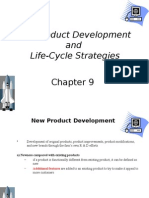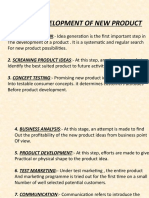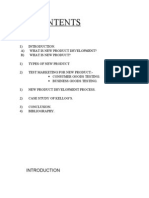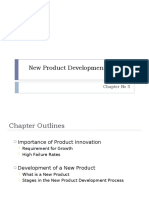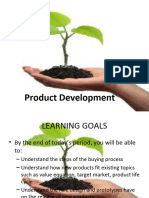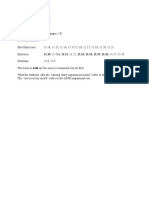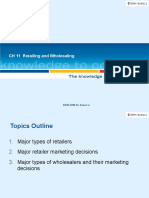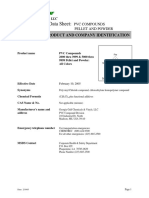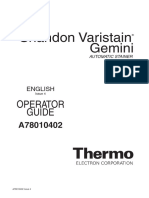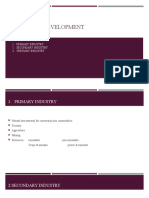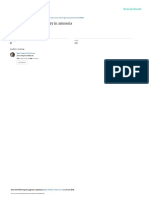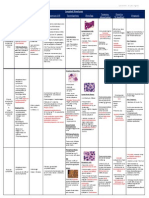0 ratings0% found this document useful (0 votes)
21 viewsCH08 (Developing Products) (Out)
CH08 (Developing Products) (Out)
Uploaded by
business docThe document discusses the new product development process and managing a product's life cycle. It outlines the 9 major stages in new product development: 1) strategy and development, 2) idea generation, 3) idea screening, 4) concept development and testing, 5) marketing strategy development, 6) business analysis, 7) development, 8) test marketing, and 9) commercialization. It also discusses managing a product through its life cycle stages of introduction, growth, maturity, and decline.
Copyright:
© All Rights Reserved
Available Formats
Download as PPTX, PDF, TXT or read online from Scribd
CH08 (Developing Products) (Out)
CH08 (Developing Products) (Out)
Uploaded by
business doc0 ratings0% found this document useful (0 votes)
21 views20 pagesThe document discusses the new product development process and managing a product's life cycle. It outlines the 9 major stages in new product development: 1) strategy and development, 2) idea generation, 3) idea screening, 4) concept development and testing, 5) marketing strategy development, 6) business analysis, 7) development, 8) test marketing, and 9) commercialization. It also discusses managing a product through its life cycle stages of introduction, growth, maturity, and decline.
Original Description:
Original Title
CH08 (Developing products)(out)
Copyright
© © All Rights Reserved
Available Formats
PPTX, PDF, TXT or read online from Scribd
Share this document
Did you find this document useful?
Is this content inappropriate?
The document discusses the new product development process and managing a product's life cycle. It outlines the 9 major stages in new product development: 1) strategy and development, 2) idea generation, 3) idea screening, 4) concept development and testing, 5) marketing strategy development, 6) business analysis, 7) development, 8) test marketing, and 9) commercialization. It also discusses managing a product through its life cycle stages of introduction, growth, maturity, and decline.
Copyright:
© All Rights Reserved
Available Formats
Download as PPTX, PDF, TXT or read online from Scribd
Download as pptx, pdf, or txt
0 ratings0% found this document useful (0 votes)
21 views20 pagesCH08 (Developing Products) (Out)
CH08 (Developing Products) (Out)
Uploaded by
business docThe document discusses the new product development process and managing a product's life cycle. It outlines the 9 major stages in new product development: 1) strategy and development, 2) idea generation, 3) idea screening, 4) concept development and testing, 5) marketing strategy development, 6) business analysis, 7) development, 8) test marketing, and 9) commercialization. It also discusses managing a product through its life cycle stages of introduction, growth, maturity, and decline.
Copyright:
© All Rights Reserved
Available Formats
Download as PPTX, PDF, TXT or read online from Scribd
Download as pptx, pdf, or txt
You are on page 1of 20
CH8
Developing New Products and Managing the Product
Life Cycle
BUSI 2208 Dr. Irene Lu
Topics
1. New product development process
2. Managing product life cycle
BUSI 2208 Dr. Irene Lu
Topic 1
The new product development process
BUSI 2208 Dr. Irene Lu
Major Stages in New Product Development
BUSI 2208 Dr. Irene Lu
Step 1. New-product strategy and
development
Using environmental scanning to identify trends that can be
opportunities or threats
Determining the type of innovation the company wishes to
pursue
BUSI 2208 Dr. Irene Lu
Step 2. Idea generation
• Systematic search for new product ideas
• Internal idea sources:
– Internal social networks
– Intrapreneurial programs
• External idea sources:
– Distributors and suppliers
– Competitors
– Customers
BUSI 2208 Dr. Irene Lu
Crowdsourcing:
• inviting broad communities of people—customers,
employees, independent scientists and researchers,
and even the public at large—into the new product
innovation process
BUSI 2208 Dr. Irene Lu
Step 3: Idea Screening
Involving internal and external evaluations of the
new-product ideas to eliminate those that warrant no
further effort
BUSI 2208 Dr. Irene Lu
Step 4. Concept Development & Testing
• Developing a product idea into alternative product
concepts
– Find out how attractive each concept is to
customers
– Choose the best one
BUSI 2208 Dr. Irene Lu
Concept Testing
• Testing new product concepts with groups of target
consumers
• Methods:
– Presenting the concepts to consumers
symbolically or physically
– Asking customers to respond by answering
questions about their reactions to the concepts
BUSI 2208 Dr. Irene Lu
Concept Testing: fuel-cell-powered electric car
An efficient, fun-to-drive, fuel-cell-powered electric
subcompact car that seats four.
This high-tech wonder runs on liquid hydrogen,
providing practical and reliable transportation with
almost no pollution.
It goes up to 90 miles per hour and, unlike battery-
powered electric cars, it never needs recharging.
BUSI 2208 Dr. Irene Lu
Questions for Fuel-Cell Electric Car Concept Test
1. Do you understand the concept of a fuel-cell-powered electric car?
2. Do you believe the claims about the car's performance?
3. What are the major benefits of the fuel-cell-powered electric car
compared with a conventional car?
4. What are its advantages compared with a batter-powered electric car?
5. What improvements in the car's features would you suggest?
6. For what uses would you prefer a fuel-cell-powered electric car to a
conventional car?
7. What would be a reasonable price to charge for the car?
8. Who would be involved in your decision to buy such a car? Who
would drive it?
9. Would you buy such a car? (Definitely, probably, probably not,
definitely not)
BUSI 2208 Dr. Irene Lu
Step 5. Marketing Strategy Development
• Initial marketing strategy for a new product
• Three parts of the marketing strategy statement:
– Describes the target market, planned value
proposition, sales, market-share, and profit goals
– Determines product’s planned price, distribution,
and marketing budget
– Develops long-run sales, profit goals, and
marketing mix strategy
BUSI 2208 Dr. Irene Lu
Step 6: Business Analysis
• A review of the sales, costs, and profit projections for
a new product
– To find out whether these factors satisfy the
company’s objectives
If no, eliminates the product concept
If yes, move to product development
BUSI 2208 Dr. Irene Lu
Step 7: Development
• Developing the product concept into a physical
product to ensure that the product idea can be turned
into a workable product
• Prototypes may be developed for testing purposes
BUSI 2208 Dr. Irene Lu
Step 8. Test Marketing
• Introduces the product and its proposed marketing
program into realistic market settings
• Gives the marketer an experience with marketing a
product before full introduction
• Tests the product and its marketing program
• Alternatives to standard test markets
– __________ test markets
– __________ test markets
BUSI 2208 Dr. Irene Lu
Step 9: Commercialization
• Introduction of the new product into the marketplace.
– When
– Where: regional rollouts
BUSI 2208 Dr. Irene Lu
Topic 2
Product life cycle
BUSI 2208 Dr. Irene Lu
Product Life Cycle
BUSI 2208 Dr. Irene Lu
Styles, Fashions, and Fads
BUSI 2208 Dr. Irene Lu
You might also like
- Imca M 252Document40 pagesImca M 252rookhnNo ratings yet
- Up 3172998 0102Document100 pagesUp 3172998 0102Sherif MoustafaNo ratings yet
- LO3 Discuss The Process Required To CommercialiseDocument35 pagesLO3 Discuss The Process Required To CommercialiseLucio Stefano100% (1)
- New Product Development and Product Life-Cycle Strategies: A Global PerspectiveDocument33 pagesNew Product Development and Product Life-Cycle Strategies: A Global PerspectiveLakshmikanthBalasubramanianNo ratings yet
- Reference Card (PDQ Sheet) : Week 1: Statistical Inference For One and Two Popula-Tion VariancesDocument50 pagesReference Card (PDQ Sheet) : Week 1: Statistical Inference For One and Two Popula-Tion Variancesbusiness docNo ratings yet
- Quiz 4 Sample QuestionsDocument4 pagesQuiz 4 Sample Questionsbusiness docNo ratings yet
- Unit IvDocument13 pagesUnit IvCommerce DepartmentNo ratings yet
- Chap 9 14032023 100043amDocument20 pagesChap 9 14032023 100043amEliz mockNo ratings yet
- Unit-3 New-Product DevelopmentDocument19 pagesUnit-3 New-Product DevelopmentPRIYA KUMARINo ratings yet
- Product Planning Process - 1Document75 pagesProduct Planning Process - 1Raman KulkarniNo ratings yet
- New Product DevelopmentDocument37 pagesNew Product DevelopmentAditya MaluNo ratings yet
- Product Development and InnovationDocument21 pagesProduct Development and InnovationMaricris Bejer Lopez100% (1)
- Introducing New Market OfferingsDocument30 pagesIntroducing New Market OfferingsVangara HarishNo ratings yet
- New PDT DevelopmentDocument53 pagesNew PDT DevelopmentravitNo ratings yet
- New Product: Development ProcessDocument15 pagesNew Product: Development Processsadiya afzalNo ratings yet
- Product Development: Don'T Find Customers For Your Products, Find Products For Your Customers"Document27 pagesProduct Development: Don'T Find Customers For Your Products, Find Products For Your Customers"Dharmesh SavitaNo ratings yet
- New-Product Development and Life-Cycle StrategiesDocument29 pagesNew-Product Development and Life-Cycle Strategiesazwan ayopNo ratings yet
- Chapter 09Document33 pagesChapter 09Anonymous ed8Y8fCxkSNo ratings yet
- Module 5 TSH NotesDocument13 pagesModule 5 TSH NotesHarishNo ratings yet
- MKT101 - Chapter 9 - TKR PDFDocument32 pagesMKT101 - Chapter 9 - TKR PDFAhnaf RaselNo ratings yet
- CH 9Document41 pagesCH 9Sathish SarmaNo ratings yet
- Developing New Products & Managing The Product Life-Cycle: K Vinod KumarDocument40 pagesDeveloping New Products & Managing The Product Life-Cycle: K Vinod KumarM JASWANTHNo ratings yet
- NPD PLC LecDocument30 pagesNPD PLC Lecviraj_wadkarvivaNo ratings yet
- Tatanexon New Product DevelopmentDocument29 pagesTatanexon New Product DevelopmentGAURAV SHARMA100% (1)
- Marketing Management 2020 - 4 5Document52 pagesMarketing Management 2020 - 4 5HAWLITUNo ratings yet
- Jan 2022. Heit 2301 - New Product DevelopmentDocument51 pagesJan 2022. Heit 2301 - New Product DevelopmentNelly MuseiNo ratings yet
- Document 7Document4 pagesDocument 7Mohamed BasharNo ratings yet
- Lecture 3 New Product DevelopmentDocument33 pagesLecture 3 New Product DevelopmentWilliam DC RiveraNo ratings yet
- Discovering New Product Development StrategyDocument7 pagesDiscovering New Product Development StrategyLi An BautistaNo ratings yet
- International Product Development Strategy: Few ExampleDocument20 pagesInternational Product Development Strategy: Few ExamplePankaj MishraNo ratings yet
- Principles of Marketing (Chapter 9)Document29 pagesPrinciples of Marketing (Chapter 9)HasibNo ratings yet
- Introduction of Product ManagementDocument23 pagesIntroduction of Product ManagementVandolf RicoNo ratings yet
- New Product DevelopmentDocument24 pagesNew Product Developmentamdan srlNo ratings yet
- Steps in Development of New Product: 1. IDEA GENERATION:-Idea Generation Is The First Important Step inDocument4 pagesSteps in Development of New Product: 1. IDEA GENERATION:-Idea Generation Is The First Important Step innarendranvelNo ratings yet
- Challenges in New Product DevelopmentDocument16 pagesChallenges in New Product DevelopmentFazal Mahmood100% (2)
- Week 6 Class 1Document9 pagesWeek 6 Class 1Abrar YasinNo ratings yet
- New Product Devp, PLCDocument19 pagesNew Product Devp, PLCTanvi DeshmukhNo ratings yet
- Entreprunership Chapter 4Document8 pagesEntreprunership Chapter 4fitsumNo ratings yet
- Product and Brand Management PSDA-1: Idea Generation: The Systematic Search For New Product IdeaDocument5 pagesProduct and Brand Management PSDA-1: Idea Generation: The Systematic Search For New Product IdeaAmartya SrivastavaNo ratings yet
- New Product Strategies PDFDocument13 pagesNew Product Strategies PDFakki0rockeyNo ratings yet
- Marketing Management - Part 8Document110 pagesMarketing Management - Part 8Ankur AggarwalNo ratings yet
- Strategy and Innovation SELF STUDYDocument16 pagesStrategy and Innovation SELF STUDYChandan GowdaNo ratings yet
- New Product Development Process: Chapter No 5Document12 pagesNew Product Development Process: Chapter No 5PhD ScholarNo ratings yet
- Group 2 Product and Process DesignDocument31 pagesGroup 2 Product and Process DesignJudeth Israel CastilloNo ratings yet
- Product DevelopmentDocument16 pagesProduct DevelopmentPiyush GargNo ratings yet
- Product DevelopmentDocument16 pagesProduct DevelopmentDevashish BiswalNo ratings yet
- Product Planning Process To Launch A New ProductDocument5 pagesProduct Planning Process To Launch A New ProductNaureen AyubNo ratings yet
- Chapter 13 Evans BermanDocument28 pagesChapter 13 Evans BermanthesimpleNo ratings yet
- Innovation Management Iii Bcom (Unit Iv)Document11 pagesInnovation Management Iii Bcom (Unit Iv)Commerce DepartmentNo ratings yet
- Pricing Decisions: Course InstructorDocument239 pagesPricing Decisions: Course Instructormalibabu .gembaliNo ratings yet
- MODULE 3 (Autosaved)Document33 pagesMODULE 3 (Autosaved)Harshit AgarwalNo ratings yet
- MTI Opportunity Identification 2024Document29 pagesMTI Opportunity Identification 2024Safriza AhmadNo ratings yet
- COMM223 Marketing Management: Lecture 7 - Product IIDocument30 pagesCOMM223 Marketing Management: Lecture 7 - Product IIfouad khouryNo ratings yet
- Priciples of Marketing by Philip Kotler and Gary Armstrong: New-Product Development and Product Life-Cycle StrategiesDocument33 pagesPriciples of Marketing by Philip Kotler and Gary Armstrong: New-Product Development and Product Life-Cycle StrategiesdontakiNo ratings yet
- New Product Concept and Development Convergence of Three MindsDocument2 pagesNew Product Concept and Development Convergence of Three MindsjanicemaeNo ratings yet
- Product DevelopmentDocument18 pagesProduct DevelopmentHeron LacanlaleNo ratings yet
- LAM Lecture 4-6 PDFDocument28 pagesLAM Lecture 4-6 PDFHayl KhadhamiNo ratings yet
- Ch08 Product Strategy and New Product DevelopmnetDocument22 pagesCh08 Product Strategy and New Product Developmnetkkyran727No ratings yet
- Chapter - 8: Innovation and New Product StrategyDocument29 pagesChapter - 8: Innovation and New Product StrategyFahimAnwarNo ratings yet
- New Product Development and Product Life-Cycle StrategiesDocument59 pagesNew Product Development and Product Life-Cycle StrategiesSarahNo ratings yet
- ENT600 - Week 5 - 9-13 NOV 2020 - Review QuestionsDocument2 pagesENT600 - Week 5 - 9-13 NOV 2020 - Review QuestionsNoorNabilaNo ratings yet
- Product Prodigy: The Ultimate Guide to Creating and Launching Profitable Online ProductsFrom EverandProduct Prodigy: The Ultimate Guide to Creating and Launching Profitable Online ProductsNo ratings yet
- The-Rules of SociologicalDocument8 pagesThe-Rules of Sociologicalbusiness docNo ratings yet
- Raising Capital: © 2019 Mcgraw-Hill Education Limited. All Rights ReservedDocument32 pagesRaising Capital: © 2019 Mcgraw-Hill Education Limited. All Rights Reservedbusiness docNo ratings yet
- Practice MCQ 5Document5 pagesPractice MCQ 5business docNo ratings yet
- Cost of Capital: © 2019 Mcgraw-Hill Education Limited. All Rights ReservedDocument43 pagesCost of Capital: © 2019 Mcgraw-Hill Education Limited. All Rights Reservedbusiness docNo ratings yet
- Dividends and Dividend Policy: © 2019 Mcgraw-Hill Education Limited. All Rights ReservedDocument30 pagesDividends and Dividend Policy: © 2019 Mcgraw-Hill Education Limited. All Rights Reservedbusiness docNo ratings yet
- 1 - Accounting Information Systems Problems With SolutionsDocument22 pages1 - Accounting Information Systems Problems With Solutionsbusiness docNo ratings yet
- 7 - AroDocument6 pages7 - Arobusiness docNo ratings yet
- 12 - Impairment of Assets Problems With Solutions: From The TextbookDocument30 pages12 - Impairment of Assets Problems With Solutions: From The Textbookbusiness docNo ratings yet
- 4 - Notes Receivable Problems With Solutions: ListaDocument21 pages4 - Notes Receivable Problems With Solutions: Listabusiness docNo ratings yet
- Practice MCQ 4Document5 pagesPractice MCQ 4business docNo ratings yet
- 6 - Property, Plant and Equipment Problems With Solutions: ListaDocument39 pages6 - Property, Plant and Equipment Problems With Solutions: Listabusiness docNo ratings yet
- CH14 (Direct, Online, Social Media, and Mobile Marketing) (Out)Document18 pagesCH14 (Direct, Online, Social Media, and Mobile Marketing) (Out)business doc100% (1)
- Practice Problems and Solutions 3process Design and Facility LayoutDocument10 pagesPractice Problems and Solutions 3process Design and Facility Layoutbusiness docNo ratings yet
- 8 - Nonmonetary Transactions Problems With SolutionsDocument9 pages8 - Nonmonetary Transactions Problems With Solutionsbusiness docNo ratings yet
- Information System Midterm Flashcards - QuizletDocument9 pagesInformation System Midterm Flashcards - Quizletbusiness docNo ratings yet
- Practice MC Questions CH 12Document3 pagesPractice MC Questions CH 12business docNo ratings yet
- 10 - Borrowing Costs PS 12edDocument15 pages10 - Borrowing Costs PS 12edbusiness docNo ratings yet
- CH06 (Customer Value-Driven Marketing Strategy) (Out)Document33 pagesCH06 (Customer Value-Driven Marketing Strategy) (Out)business docNo ratings yet
- CH11 (Retailing and Wholesaling) (Out)Document17 pagesCH11 (Retailing and Wholesaling) (Out)business docNo ratings yet
- CH13 (Personal Selling and Sales Promotion) (Out)Document13 pagesCH13 (Personal Selling and Sales Promotion) (Out)business docNo ratings yet
- Sample Final Exam Questions W19 March 31 With Answers - Leverage DividendsDocument3 pagesSample Final Exam Questions W19 March 31 With Answers - Leverage Dividendsbusiness docNo ratings yet
- Practice MC Questions CH 14Document4 pagesPractice MC Questions CH 14business docNo ratings yet
- Practice MC Questions CH 11Document3 pagesPractice MC Questions CH 11business docNo ratings yet
- 1931 Trails To Inmost Asia by Roerich SDocument603 pages1931 Trails To Inmost Asia by Roerich SKurt W. Wagner100% (6)
- PVC MSDSDocument9 pagesPVC MSDSSandry KesumaNo ratings yet
- Gemini A78010402 Manual Issue 4Document51 pagesGemini A78010402 Manual Issue 4Edy_AlemanNo ratings yet
- D. Difficult C. Like C. Garden B. Arrange A. Over: The First Term TestDocument2 pagesD. Difficult C. Like C. Garden B. Arrange A. Over: The First Term TestHạ VũNo ratings yet
- Industrial Development: Types of IndustriesDocument12 pagesIndustrial Development: Types of IndustrieslearnerNo ratings yet
- Comparison of 310s, CoCr and Inconel 625Document6 pagesComparison of 310s, CoCr and Inconel 625Fathia AlkelaeNo ratings yet
- Answer Key From 901 1100Document10 pagesAnswer Key From 901 1100Dương NèNo ratings yet
- Autobiographical Memory in AmnesiaDocument11 pagesAutobiographical Memory in AmnesiaCarlosNo ratings yet
- Felocell 4 Canadian English SdsDocument7 pagesFelocell 4 Canadian English SdsPurple MoonNo ratings yet
- Animal RaisingDocument16 pagesAnimal RaisingDeo SalesNo ratings yet
- How To Size A Room Air Conditioner PDFDocument3 pagesHow To Size A Room Air Conditioner PDFKo PaukNo ratings yet
- Khúng KhéngDocument24 pagesKhúng KhéngVũ Thị Ngọc AnhNo ratings yet
- Veterinary Dermatology - 2021 - Santoro - Clinical Signs and Diagnosis of Feline Atopic Syndrome Detailed Guidelines For ADocument19 pagesVeterinary Dermatology - 2021 - Santoro - Clinical Signs and Diagnosis of Feline Atopic Syndrome Detailed Guidelines For AAmanda MarquesNo ratings yet
- Mathematical Olympiad Math Olympiad TutorialsDocument62 pagesMathematical Olympiad Math Olympiad TutorialsClaudio Perez100% (1)
- UntitledDocument23 pagesUntitledMarian Nicole NalicaNo ratings yet
- Chocolate Making Process IndiaDocument80 pagesChocolate Making Process IndiaEng_2014No ratings yet
- CNCDocument2 pagesCNCDr-naser MahmoudNo ratings yet
- Atomic Structure (Past Papers Questions)Document1 pageAtomic Structure (Past Papers Questions)zafarchem_iqbalNo ratings yet
- RBI 2006 2008Pg180Document158 pagesRBI 2006 2008Pg180bheekhara100% (1)
- E3LM10 Level Monitoring of Conductive LiquidsDocument3 pagesE3LM10 Level Monitoring of Conductive LiquidsClaudia Patricia Carazas SarmientoNo ratings yet
- Soal Ulangan Bahasa Inggris Kelas XDocument4 pagesSoal Ulangan Bahasa Inggris Kelas XRapliNo ratings yet
- IV TherapyDocument3 pagesIV TherapyYalc LapidNo ratings yet
- Tugas 5 B.ingDocument4 pagesTugas 5 B.ingĎŲ ĞÕĞNo ratings yet
- DC Motor Speed Control With Feedback Monitor Based On C# ApplicationDocument4 pagesDC Motor Speed Control With Feedback Monitor Based On C# ApplicationesatjournalsNo ratings yet
- Language ProficiencyDocument43 pagesLanguage ProficiencyRlan PntoNo ratings yet
- Wind Energy Conversion SystemDocument16 pagesWind Energy Conversion SystemdineshNo ratings yet
- MEPC.190 (60) Revised MARPOL Annex VI North American ECADocument9 pagesMEPC.190 (60) Revised MARPOL Annex VI North American ECAmarinelaraNo ratings yet
- WBC Neoplasms Review - PathologyDocument6 pagesWBC Neoplasms Review - Pathologylas100% (6)
















